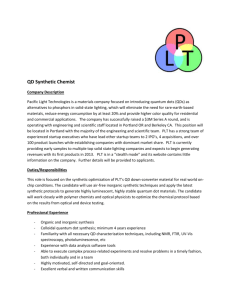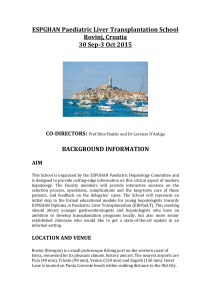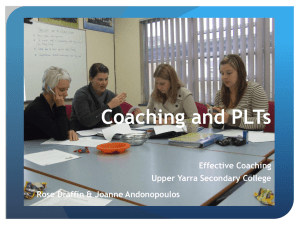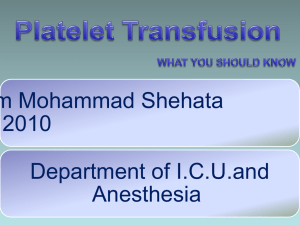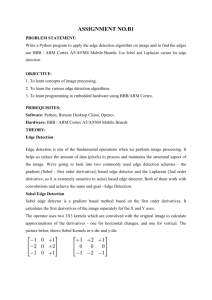Contextual analysis of the school context and initial development of
advertisement
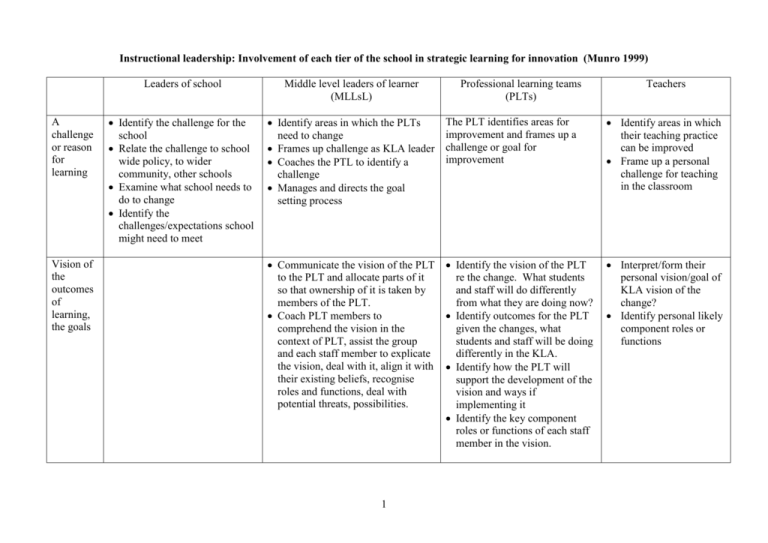
Instructional leadership: Involvement of each tier of the school in strategic learning for innovation (Munro 1999) A challenge or reason for learning Vision of the outcomes of learning, the goals Leaders of school Middle level leaders of learner (MLLsL) Identify the challenge for the school Relate the challenge to school wide policy, to wider community, other schools Examine what school needs to do to change Identify the challenges/expectations school might need to meet Identify areas in which the PLTs need to change Frames up challenge as KLA leader Coaches the PTL to identify a challenge Manages and directs the goal setting process The PLT identifies areas for improvement and frames up a challenge or goal for improvement Identify areas in which their teaching practice can be improved Frame up a personal challenge for teaching in the classroom Communicate the vision of the PLT to the PLT and allocate parts of it so that ownership of it is taken by members of the PLT. Coach PLT members to comprehend the vision in the context of PLT, assist the group and each staff member to explicate the vision, deal with it, align it with their existing beliefs, recognise roles and functions, deal with potential threats, possibilities. Identify the vision of the PLT re the change. What students and staff will do differently from what they are doing now? Identify outcomes for the PLT given the changes, what students and staff will be doing differently in the KLA. Identify how the PLT will support the development of the vision and ways if implementing it Identify the key component roles or functions of each staff member in the vision. Interpret/form their personal vision/goal of KLA vision of the change? Identify personal likely component roles or functions 1 Professional learning teams (PLTs) Teachers Use existing knowledge See a pathway to the goal Identify what the school knows (abstract, experiential) about the domain of the change Put in place processes for gathering this knowledge and examine the extent to which this is sufficient to support change Identify the school’s attitude to and confidence in changing, its preparedness to take risks, and implements procedures to identify this Identify the school’s level of commitment to changing, preparedness to display an expectation that the change will occur Identify the processes in the school that will allow the change to occur, what the school knows about how to manage, direct and monitor the change Develop a school-wide pathway that shows steps to the goal. This brings together different component pathways and takes account of several agendas Identify school level indicators or measures of the success of the change Implement procedures to collage PLT knowledge that is relevant to the change Implements procedures that allow relevant PLT knowledge to be displayed to the group and valued Identify the processes necessary to increase PLT knowledge and to facilitate collegiate learning. What does the PLT leader know about how to lead group learning/coach attitude change? Assist each teacher to be prepared to share knowledge, to analyse their teaching, to identify possible areas for improvement. Identify that it knows (abstract, experimental) at present that is relevant to the change. What are the PLT’s attitude to and confidence in changing? Identifies what the PLT know about how to manage, direct and monitor the change process. What are the questions to which the PLT currently doesn’t have answers? Identify what it believes about the need to change and level of its goal congruence re change. Lead the PLT to develop and implement an action plan Lead the group to identify indicators of success Identify processes the leader can use to monitor progress Coach PLT to contextualise, review, fine tune, modify the action plan 2 Develop an explicit action plan that indicates steps the PLT to achieve the goal Identify indicators of tis success, procedures the PLT will take to monitor and review progress Identify what they know that is relevant to the change; identify current problems the change will solve in their work. How prepared each staff member is to share that knowledge? Identify their attitude to and confidence re the change? Identify their explicit action plan Identify indicators of their success and how progress will be monitored Learn new ideas in specific contexts Provide opportunities for exploration of innovation in specific contexts Support encourages questioning of new ideas, focus on specific possibilities Support encourage new experiences, sharing of new experiential knowledge Put in place an opportunity for staff to learn new ideas, to proceduralise these as innovative teaching procedures and to trial these in specific contexts, perhaps using action research Coach staff in specific aspects of new ideas Lead in innovation and learning in KLA Put in place collegiate learning opportunities Put in place processes for feedback to colleagues Learns about the innovation in collegiate activities and trial innovative teaching procedures in particular contexts in their teaching Support peers to practice and trial innovations before implementing them in classroom Develop procedures for collating knowledge of outcomes re innovation Abstract, decontextualise what they have learnt Provide opportunities for school to abstract and generalise the new knowledge Identify aspects of innovation that can inform improved practice in the school Communicate the outcomes of the learning to other agencies Assist staff to analyse and generalise the learning outcomes of the PLT Foster awareness of using outcomes to improve knowledge and teaching practice in the PLT Analyse and generalise what other PLTs have learnt about innovative practice Feed these into improved practice in the KLA. Invest positive emotion in the new knowledge Model the display of valuing of innovative outcomes, explicitly shows a school wide valuing of the innovative outcomes Explicitly build up the self efficacy of the school, develop the attitude of school as valuing innovation Implement procedures to develop an intrinsic motivation to learn, to help each teacher to get increased motivation to continue Coach the PLT and individual staff in self efficacy and to invest positive emotion in the innovation Provides feedback to PLT Fosters goal congruence Help PLT members see their competence increasing Help the PLT take ownership for the ideas, innovation 3 Manage and directs the learning of the group, prioritise how the learning and group activities will develop Identify the value and usefulness of the learning outcomes Monitor how the learning progress is contributing to the knowledge of the group Work in peer pairs to plan, implement, research and monitor a teaching innovation as a small scale teaching project Identify the more general aspects of the outcomes of the innovation Trial the outcomes of PLT peers Focus on improved practice Manage and direct their aspects of the innovation Note the value of innovation at a personal level Note how the implementation of the component to innovation was due to the capacity to the individual staff member Store what they have learnt in memory, practise remembering it Identify the new knowledge that will become part of the school’s “code of teaching practice” Coach the PLT and individual staff in procedures for remembering and using the innovation Plan procedures to assist the PLT to retain the outcomes of the innovation, for example, PLT review sessions, poster displays in staff room, establishing groups to work on operationalising and modelling aspects of the innovation that is relevant to the PLT 4 Put in place procedures to retain within the PLT and KLA the knowledge gained, for example, in shared teaching activities, on faculty web page Summarise the outcomes of the innovation Note how the innovation outcomes are similar to/different from existing practice, operationalise the key outcomes of the innovation Develop memory retention procedures, mnemonics Refer to and use the outcomes of the innovation in subsequent practice within the KLA Review the key outcomes of the innovation, what they mean for their practice Notes how the innovation outcomes are similar to/different from their existing practice Develop a plan to operationalise the key outcomes of the innovation and trials them in their teaching Develop memory retention procedures, mnemonics to retain the new ideas Refer to and use the outcomes of the innovation in subsequent practice within their practice Identify how they learn, what they did that helped them to learn Implement procedures to identify and collate what the school learnt about how to learn, to manage change to innovate, the actions that worked Foster a valuing of reflection on learning and thinking See progress being made Transfer, apply and generalise the new knowledge Develop indicators for monitoring the progress of the school and procedures for mapping progress against these Foster an attitude towards seeing progress being made Lead the school to celebrate progress Analyse the innovation on a school-wide basis in terms of its Relevance to school wide policy Relationship to other agencies such as the parent body, other schools Future development in the school Its relevance for dealing with other problems, far transfer Key variables, for example, economic factors, HR Develop activities to assist the PLT to reflect on and collate the ways of thinking that facilitated innovative outcomes in the PLT Coach individual members and the group in ways of thinking Note the variety of ways of thinking in the PLT and the extent to which members might broaden their ways of thinking Foster an attitude towards seeing progress being made in the KLA Lead the KLA to celebrate progress Reflect on and collate the ways of thinking that facilitated innovative outcomes in the PLT Develop its language for talking about group thinking and individual thinking Note the ways of thinking it will be more likely to use in the future and when Develop indicators for monitoring the progress of PLT and procedures for mapping progress against these Identify progress and gains Develop indicators for monitoring individual progress, possibly in terms of student achievement, attitudes and how to learn Implements activities to assist PLT to examine extent to which innovation can be transferred and generalised Examine where else the innovation may be used Examine the relevance of the innovation for enhancing other aspects of the PLT (far transfer) Identify ways of gathering data re the values of transfer Dealing with problems in the PLT Professional learning team (PLT) could be a subject faculty, department in a primary or secondary school KLA: learning area, subject or discipline area. 5 Reflect on the ways of thinking that assisted them to complete their component of the innovation Note the ways of thinking they will be more likely to use in the future and when Undertakes to trial the ways of thinking used by other PLT members. Instructional leadership: Involvement of each tier of the school in strategic learning for innovation (Munro 1999) Planning template Leaders of school Middle level leaders of learner (MLLsL) A challenge or reason for learning Vision of the outcomes of learning, the goals 6 Professional learning teams (PLTs) Teachers Use existing knowledge See a pathway to the goal 7 Learn new ideas in specific contexts Abstract, decontextualise what they have learnt Invest positive emotion in the new knowledge 8 Store what they have learnt in memory, practise remember ing it Identify how they learn, what they did that helped them to learn See progress being made Transfer, apply and generalise the new knowledge 9

